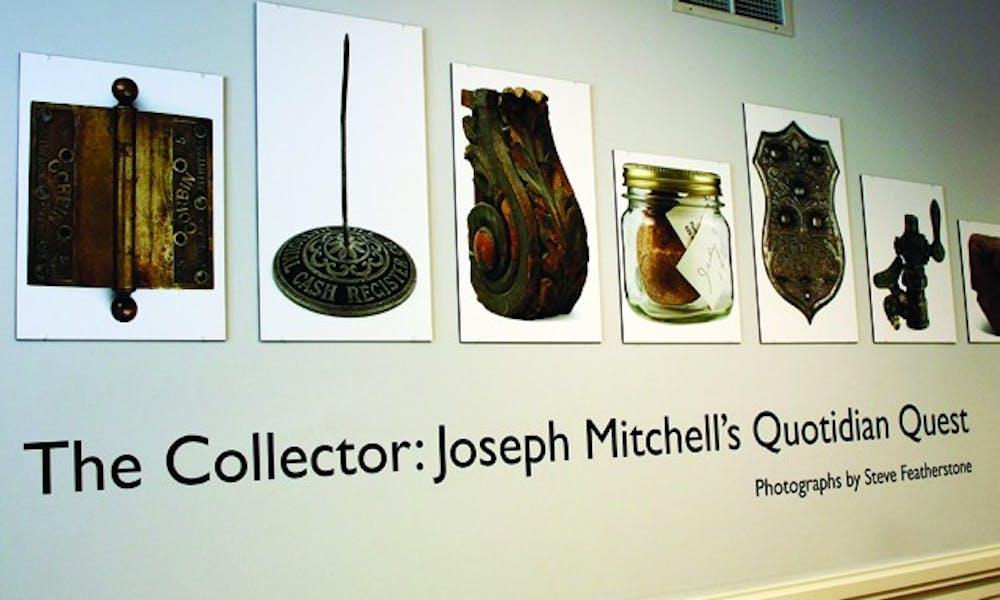Joseph Mitchell, the iconic New Yorker writer with roots in Fairmont, N.C., started furiously collecting doorknobs, nails, bottles and the like around the time he stopped publishing his profiles of misfits, cranks and other ordinary characters that, collectively, reflected the pulse of the New York City he encountered in 1929. His last, and best, profile, “Joe Gould’s Secret,” appeared in two parts in 1964. And even though he trudged to the typewriter in his office for the next 31 years, he never published another piece in the magazine.
“Yes, he wrote. He wrote all the time,” his daughter, Liz, said recently at the Center for Documentary Studies, which hosted a discussion and reception for The Collector, an exhibit of photographs of the knick-knacks Mitchell built up over the years. With about 75 other guests, Mitchell’s daughter sat in the back row of the small auditorium, and she listened to Steve Featherstone, the exhibit’s photographer, and Paul Maliszewski, the writer, talk about their project as high-resolution snapshots of the vases and floortiles and everything else Mitchell collected scrolled on a drop-down projector behind them.
Through his written works—which, in book form, rested on the mantle over a fireplace in one the exhibition’s two expansive rooms—Mitchell is often said to be New York City’s equivalent of James Joyce, who wanted Ulysses to be detailed enough to rebuild Dublin should catastrophe strike. Mitchell’s collection operates the same way. Instead of meticulous portraits with understated sentences, Mitchell’s blueprint for the city consists of rocks, buttons and tiles.
Featherstone and Maliszewski came across the collection when they visited Nora Sanborn, Mitchell’s other daughter, in New Jersey and combed through box upon box, only to discover the other half of the collection waited at Liz’s home.
“It was, just—” said Featherstone, searching for the word.
“Speechless,” said Maliszewski, who first wrote extensively about the collection in a 2004 issue of Granta. “I think we’re still speechless.”
“Well, yeah.”
They found, among so many other memorables: navy Brooks Brothers boxes with gold trim, filled with rocks from 1974; two cut nails pulled from bricks in the classic Tiffany’s box, complete with white bow; badges to reward perfect Sunday School attendance that Mitchell found in his childhood home; and, from the day Liz married in the Plaza Hotel, a loose doorknob that Mitchell pilfered and then presented to his daughter as a gift. “It’s not the type of thing you see at Sotheby’s,” Featherstone said.
From there, it was Featherstone’s duty to photograph the collection—to capture, as he said, “the thingyness of the thing.” Most of the pieces are offset with piercing white backgrounds, which blended gently with the light gray walls of the exhibition. There are few tags for identification. For some, there were notes, scribbled and typed on New Yorker letterhead. The earliest dates back to July 10, 1969. (“I liked stuff that came with notes,” Featherstone said wryly.) As the exhibition continues into the second room, there are more quotes about Mitchell from other writers—testimonials, as if he needed further validation.
“This wasn’t something he was grabbing off the streets and not thinking about again,” Maliszewski said. “It was reporter’s habit of seeing and understanding.”
As a reporter, Mitchell was almost unparalleled. He spent months observing his subjects, gripping the cadence of their diction as he observed their interactions with the people around them, and in his profiles, he wrote with that wonderful writerly trait: empathy. He presented fact as such, and he never passed judgment. Even when he was a character—as he was in his sprawling profile of Joe Gould, of course—Mitchell wrote directly and honestly, with easy, lyrical prose.
In this collection, Mitchell’s medium wasn’t words, but artifacts. If his magazine pieces captured the soul of New York City, then the collection was another sort of profile: one of the architecture and spectacle of New York City. The charm of Mitchell’s collection rested not in the individual beauty of the objects, but in the collective value of the time capsule.
“Do either of you collect anything?” asked Courtney Reid-Eaton, the discussion’s moderator, who joined the two on an elevated stage.
“I try not to,” Featherstone said, “because it’s one of those things that you cannot stop once you start.”
“I asked my wife on the drive down if I collect anything,” Maliszewski said. “And she said, ‘You collect everything.’”
“Some people would say they don’t collect,” Reid-Eaton said. “But I think everybody collects. I think we can’t help it.”
Get The Chronicle straight to your inbox
Sign up for our weekly newsletter. Cancel at any time.

